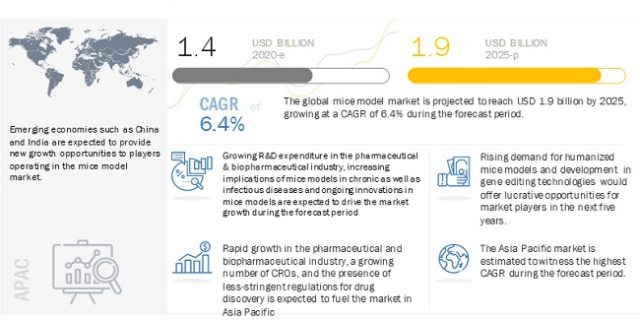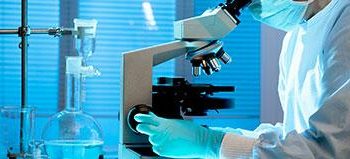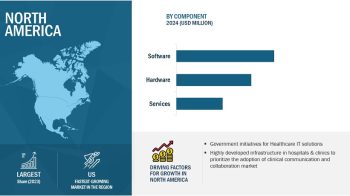
Growing R&D expenditure in the pharmaceutical & biopharmaceutical industry, increasing implications of mouse clinical trials (MCTs) for more predictive outcomes, and ongoing innovations in mice models are driving the growth of the global mice model industry.
The global mice model market size is projected to reach USD 1.9 billion by 2025 from USD 1.4 billion in 2020, at a CAGR of 6.4%. Mice Model Market by Mice Type (Inbred, Knockout), Technology (CRISPR, TALEN, ZFN), Application (Oncology, Diabetes, Immunology), Service (Breeding, Cryopreservation, Genetic testing), Care Products (Cages, Bedding, Feed), Region – Global Forecast to 2025.
Rising demand for humanized mice models
Humanized mice models are important tools for conducting preclinical research to gain insights into human biology. These models are developed through the engraftment of human cells or tissues, leading to the expression of human proteins in mice.
Humanized mice are increasingly being used as models for biomedical research applications, such as cancer, infectious diseases, HIV/AIDS, regenerative medicine, and hepatitis. In March 2019, the National Institute of Allergy and Infectious Diseases (NIAID), an agency of the US Department of Health and Human Services, announced funding for projects to conduct detailed characterization, direct comparisons, and further development of humanized immune system (HIS) mouse models. The need to identify the actual effects of drugs on humans, as well as the growing focus on studying human-specific infections, therapies, and immune responses, is promoting the development and use of humanized mice models.
Download PDF Brochure: https://www.marketsandmarkets.com/pdfdownloadNew.asp?id=1308
Based on application, the mice model market has been segmented into oncology studies, immunology and inflammation studies, endocrine metabolic studies, cardiovascular studies, central nervous system studies (CNS), genetic studies, infectious disease studies, and other disease studies. The endocrine disease studies is further segmented into diabetes and other endocrine metabolic disease. The oncology segment is expected to account for the largest market share in 2020, with the highest growth rate as well. This can primarily be attributed to the increasing number of patients who have cancer and the subsequent increase in the demand for cancer therapies.
Based on the type of technology used to create transgenic mice, the mice model market is categorized into the CRISPR/Cas9, microinjection, embryonic stem cell injection, nuclear transfer, and other technologies (includes virus/vector-mediated gene transfer, and TALENs & ZFNs) segments. CRISPR is the most widely used technology in the mice model market and contributed to the largest share of the mice model market in 2020. Ease of design, high efficiency, and relatively lower cost have increased the demand for CRISPR-customized mice models.
North America accounted for the largest share of the mice model market in 2019
Based on the region, the global mice model market is segmented into North America, Europe, the Asia Pacific, and Rest of the World. In 2019, North America accounted for the largest share of the mice model market. The large share of the North America region can be attributed to the presence of major players operating in the mice model market in the US, growing biomedical research in the US, and rising preclinical activities by CROs and pharmaceutical companies in the region.
Request for Sample Pages: https://www.marketsandmarkets.com/requestsampleNew.asp?id=1308
Key Players
Charles River Laboratories, (US) The Jackson Laboratory (US), Taconic Biosciences, Inc. (US), Envigo (US), JANVIER LABS (France), genOway (France), PolyGene (Switzerland), Crown Biosciences (US), TransCure bioservices (France), Ingenious Targeting Laboratory (US), Cyagen Biosciences (US), GVK BIO (India), The Andersons, Inc. (US), Innovive (US), Allentown, LLC (US), FENGSHI Group (China), Ozgene Pty Ltd. (Australia), and Harbour Biomed (US)

